Glycolysis Process
Glycolysis is the central pathway for glucose catabolism. In this process, glucose, a 6-carbon compound, is converted into pyruvate, a 3-carbon compound. This sequence of reactions involves 10 steps and is crucial for the metabolism of glucose in both aerobic and anaerobic organisms.
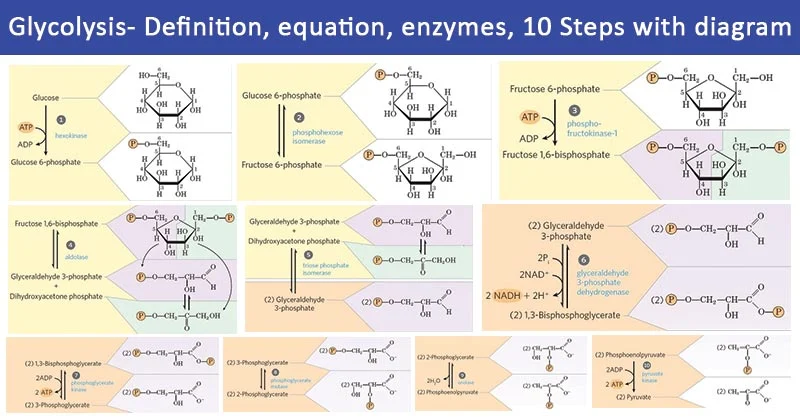
Glycolysis in Aerobic vs. Anaerobic Organisms
Glycolysis occurs in both aerobic and anaerobic organisms. In aerobic organisms, glycolysis precedes the citric acid cycle and electron transport chain, releasing most of the energy from glucose. In anaerobic organisms, glycolysis is the primary source of energy production.
Glycolysis Equation
The summary equation for glycolysis is:
C6H12O6 (Glucose) + 2ADP (Adenosine diphosphate) + 2Pi (Phosphate) + 2NAD+ (Nicotinamide adenine dinucleotide) → 2C3H4O3 (Pyruvate) + 2H2O (Water) + 2ATP (Adenosine triphosphate) + 2NADH + 2H+ (Hydrogen ions).
Glycolysis Enzymes
The enzymes catalyzing glycolysis are located in the cytosol (cytoplasm) and mostly require Mg2+. Key enzymes include:
- Hexokinase
- Phosphoglucoisomerase
- Phosphofructokinase
- Aldolase
- Phosphotriose isomerase
- Glyceraldehyde 3-phosphate dehydrogenase
- Phosphoglycerate kinase
- Phosphoglycerate mutase
- Enolase
- Pyruvate kinase
Glycolysis: A Step-by-Step Breakdown
Glycolysis is the process where glucose (a 6-carbon sugar) is broken down into two molecules of pyruvate (a 3-carbon compound) via 10 enzyme-catalyzed reactions. It is divided into two phases: Phase I (Preparatory) and Phase II (Energy-Conserving). Let's explore the 10 steps of glycolysis:
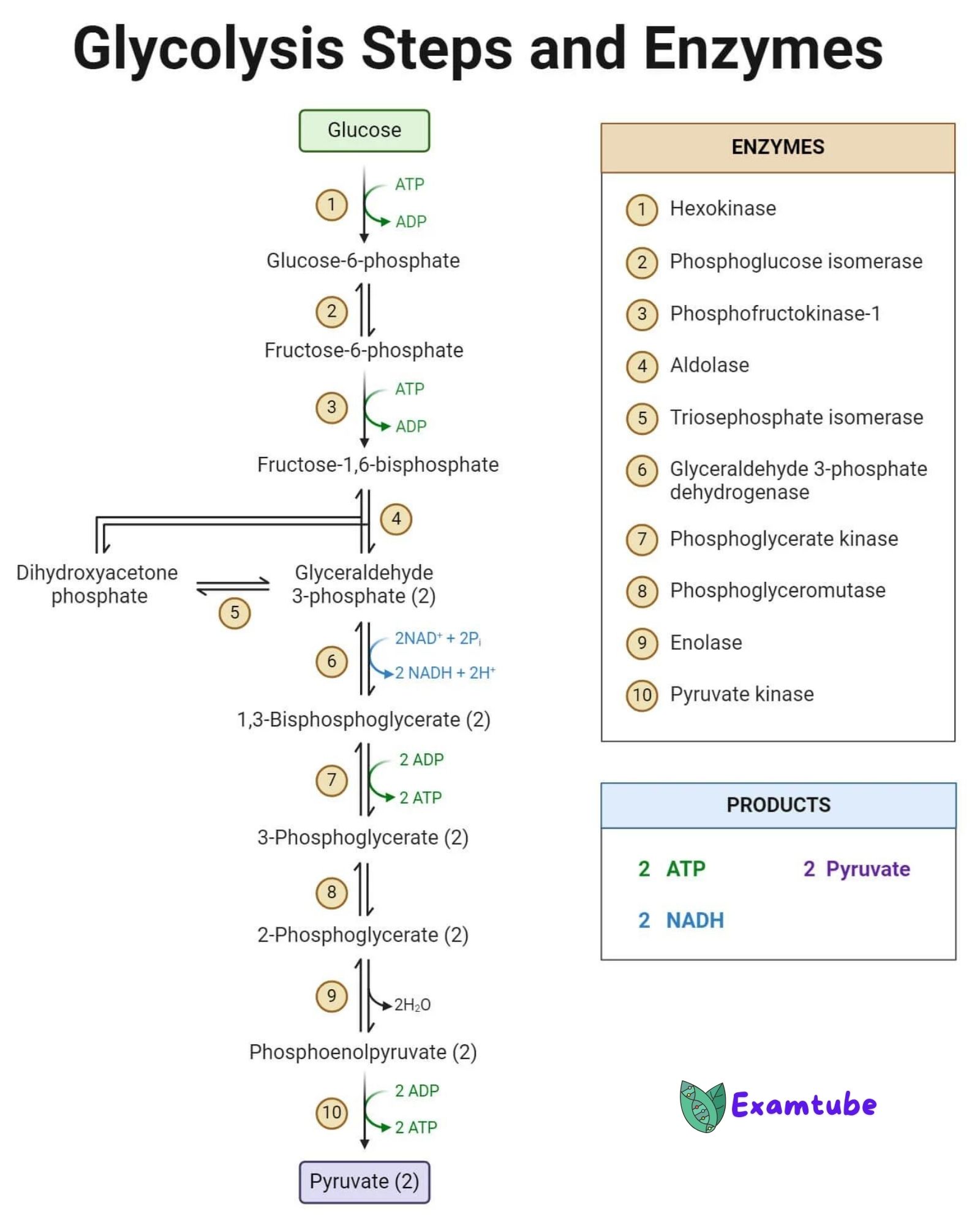
1. Phosphorylation of Glucose
In the first step, glucose is phosphorylated at the C6 carbon to form glucose-6-phosphate. The enzyme hexokinase (in humans) or glucokinase (in microbes) catalyzes this reaction. ATP provides the phosphate group, and some energy is lost as heat.
Example: Saccharomyces cerevisiae (Baker's yeast), Escherichia coli (E. coli), Homo sapiens (Humans)
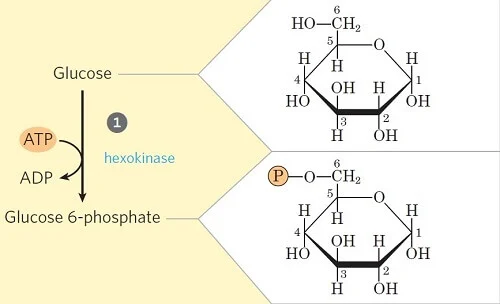
2. Isomerization of Glucose-6-Phosphate
In the second step, glucose-6-phosphate is converted to fructose-6-phosphate by the enzyme phosphohexose isomerase. This reaction shifts the carbonyl oxygen from C1 to C2, transforming an aldose sugar into a ketose form.
Example: Saccharomyces cerevisiae (Baker's yeast), Zea mays (Corn), Pisum sativum (Pea plant)
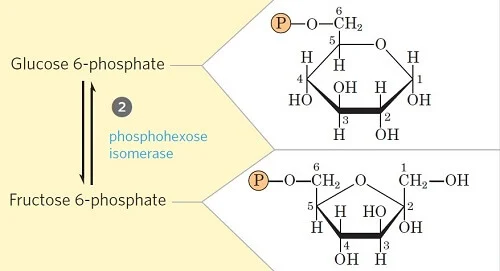
3. Phosphorylation of Fructose-6-Phosphate
In the third step, fructose-6-phosphate is converted to fructose-1,6-bisphosphate by the enzyme phosphofructokinase. Another ATP molecule donates a phosphate group to this reaction, with energy again released as heat.
Example: Saccharomyces cerevisiae (Baker's yeast), Oryza sativa (Rice), Homo sapiens (Humans)
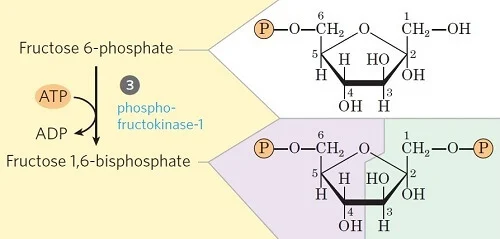
4. Cleavage of Fructose-1,6-Bisphosphate
This step involves the splitting of fructose-1,6-bisphosphate into two triose phosphates: glyceraldehyde 3-phosphate and dihydroxyacetone phosphate. The enzyme aldolase catalyzes this reaction.
Example: Aspergillus niger (Black mold), Arabidopsis thaliana (Thale cress), Bos taurus (Cattle)
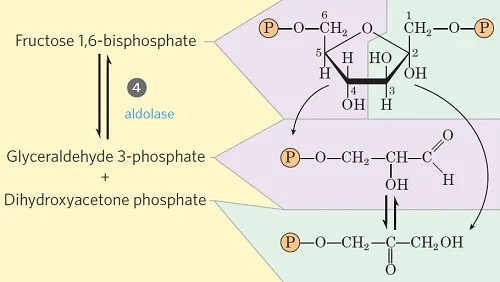
5. Isomerization of Dihydroxyacetone Phosphate
In this step, dihydroxyacetone phosphate is converted to glyceraldehyde 3-phosphate by the enzyme triose phosphate isomerase. Now, all molecules in the pathway are in the form of glyceraldehyde 3-phosphate, completing the first phase of glycolysis.
Example: Saccharomyces cerevisiae (Baker's yeast), Triticum aestivum (Wheat), Homo sapiens (Humans)
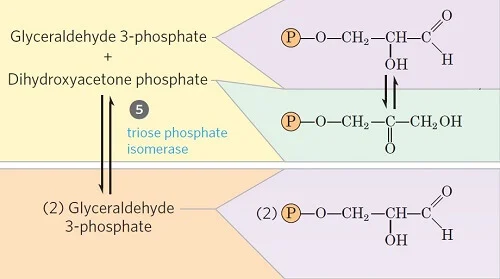
Energy-Conserving Phase (Phase II)
6. Oxidative Phosphorylation of Glyceraldehyde 3-Phosphate
This is an energy-generating step where glyceraldehyde 3-phosphate is converted to 1,3-bisphosphoglycerate. The enzyme glyceraldehyde 3-phosphate dehydrogenase facilitates this, and two NADH molecules are produced as NAD+ is reduced.
Example: Escherichia coli (E. coli), Saccharomyces cerevisiae (Baker's yeast), Homo sapiens (Humans)
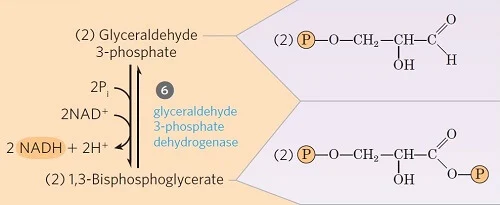
7. Phosphate Transfer from 1,3-Bisphosphoglycerate to ADP
The phosphate group from 1,3-bisphosphoglycerate is transferred to ADP, producing ATP and 3-phosphoglycerate. The enzyme phosphoglycerate kinase catalyzes this step. Two ATP molecules are generated per glucose molecule.
Example: Saccharomyces cerevisiae (Baker's yeast), Oryza sativa (Rice), Homo sapiens (Humans)
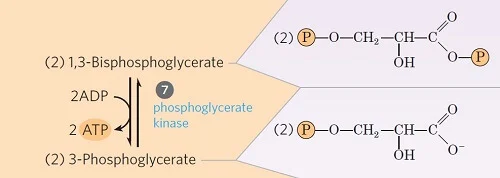
8. Isomerization of 3-Phosphoglycerate
In this step, 3-phosphoglycerate is isomerized to 2-phosphoglycerate by the enzyme phosphoglycerate mutase, which moves the phosphate group from the third to the second carbon.
Example: Escherichia coli (E. coli), Arabidopsis thaliana (Thale cress), Homo sapiens (Humans)

9. Dehydration of 2-Phosphoglycerate
2-phosphoglycerate is dehydrated (loses water) to form phosphoenolpyruvate in the presence of the enzyme enolase. This reaction is irreversible, and two water molecules are released per glucose molecule.
Example: Saccharomyces cerevisiae (Baker's yeast), Zea mays (Corn), Homo sapiens (Humans)
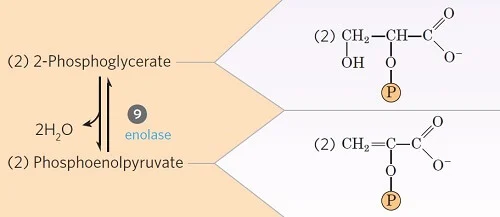
10. Transfer of Phosphate from Phosphoenolpyruvate
In the final step, phosphoenolpyruvate donates its phosphate group to ADP, forming ATP and pyruvate. The enzyme pyruvate kinase catalyzes this step, generating two ATP molecules. Pyruvate will later enter the citric acid cycle or undergo fermentation.
Example: Saccharomyces cerevisiae (Baker's yeast), Arabidopsis thaliana (Thale cress), Homo sapiens (Humans)
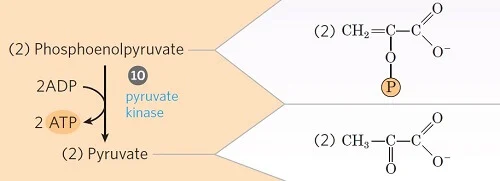
Result of Glycolysis
The overall process of glycolysis results in several key events. Glucose is oxidized into pyruvate. NAD+ (nicotinamide adenine dinucleotide) is reduced to NADH. ADP (adenosine diphosphate) is phosphorylated to form ATP (adenosine triphosphate). This sequence provides the foundation for further metabolic pathways.
Fates of Pyruvate
Depending on the organism and metabolic conditions, pyruvate can take one of the following three essential routes:
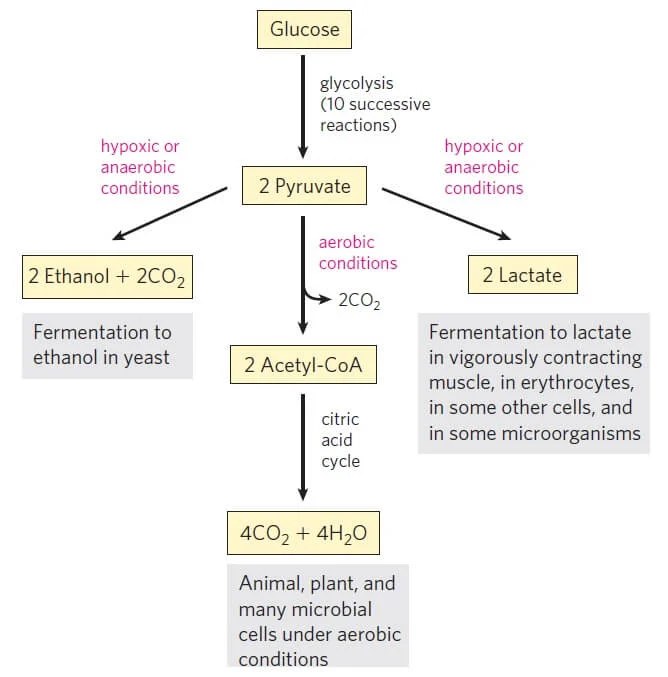
1. Oxidation of Pyruvate
In aerobic organisms, pyruvate is transported to the mitochondria and oxidized into the acetyl group of acetyl-coenzyme A (acetyl Co-A). This process releases CO2 (carbon dioxide). The acetyl CoA then enters the citric acid cycle, where it is fully oxidized into CO2 and H2O (water).
2. Lactic Acid Fermentation
When oxygen is insufficient, such as in skeletal muscle cells, pyruvate cannot be oxidized. Instead, it is reduced to lactate in anaerobic glycolysis. This occurs in organisms that experience low oxygen availability, including some bacteria. An example is Lactobacillus acidophilus (common bacteria in yogurt, often referred to as acidophilus).
3. Alcoholic Fermentation
In certain microbes like Saccharomyces cerevisiae (brewer’s yeast), pyruvate is anaerobically converted into ethanol and CO2. This is one of the most ancient forms of glucose metabolism. Such fermentation processes are crucial for producing alcoholic beverages and bread.
Significance of the Glycolysis Pathway
All tissues use the glycolytic pathway to break down glucose, providing ATP for energy. This pathway is especially important under anaerobic conditions. It generates energy even in cells without mitochondria and produces intermediates for other metabolic pathways. For example, Plasmodium falciparum (a parasite causing malaria) relies heavily on glycolysis.
Glycolysis-Associated Diseases
Deficiencies in any glycolytic enzyme result in hemolytic anemia because RBCs (red blood cells) depend entirely on glycolysis for energy. Without energy, the cells break down. A notable example is Pyruvate kinase deficiency, a condition that leads to chronic anemia and affects blood cell function.
Glycolysis (FAQs)
What is aerobic glycolysis?
Aerobic glycolysis is the process where glucose is oxidized into pyruvate, followed by further oxidation into CO2 (carbon dioxide) and H2O (water) in the presence of sufficient O2 (oxygen). It occurs in cells when oxygen levels are adequate.
What is anaerobic glycolysis?
Anaerobic glycolysis occurs when there is an insufficient supply of oxygen. In this process, pyruvate is converted into lactate (lactic acid), and NADH is reoxidized into NAD+. This pathway is essential for producing energy in oxygen-limited environments.
Where does glycolysis occur?
Glycolysis takes place in the cell's cytosol (fluid part of the cytoplasm). It is a crucial metabolic pathway in both prokaryotic and eukaryotic cells.
What are the products of glycolysis?
The products of glycolysis are two moles of pyruvate, four moles of ATPs (net gain of 2 ATPs), and two moles of NADH. These molecules are crucial for energy production and further metabolic pathways.
How many NADH are produced by glycolysis?
Glycolysis produces two moles of NADH. This molecule is used in the electron transport chain during cellular respiration for the production of more ATP.
How many ATPs are formed in glycolysis?
A total of four moles of ATPs are produced during glycolysis, but the net gain is only 2 ATPs because 2 ATPs are used up during the preparatory phase of the pathway.
What are the functions of glycolysis?
The primary function of glycolysis is to produce ATP (energy). It also generates pyruvate, which is further oxidized to produce additional ATP. This process is vital for energy production in almost all living organisms.



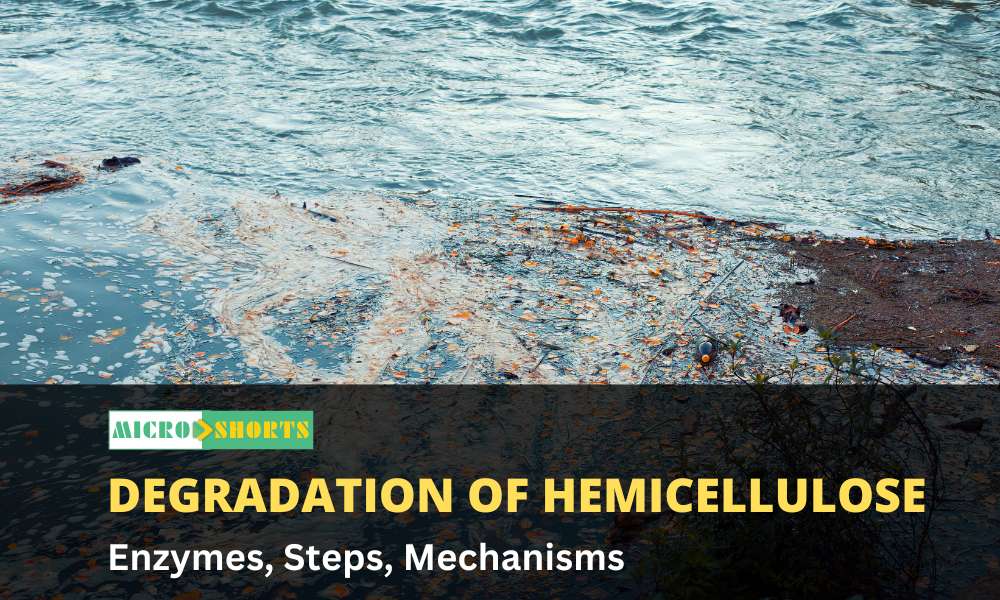
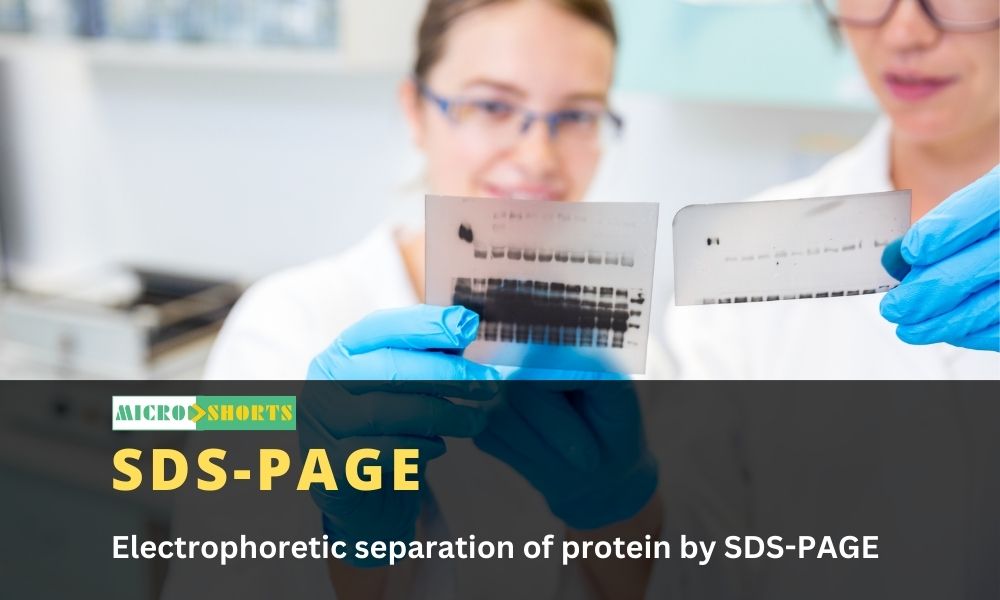
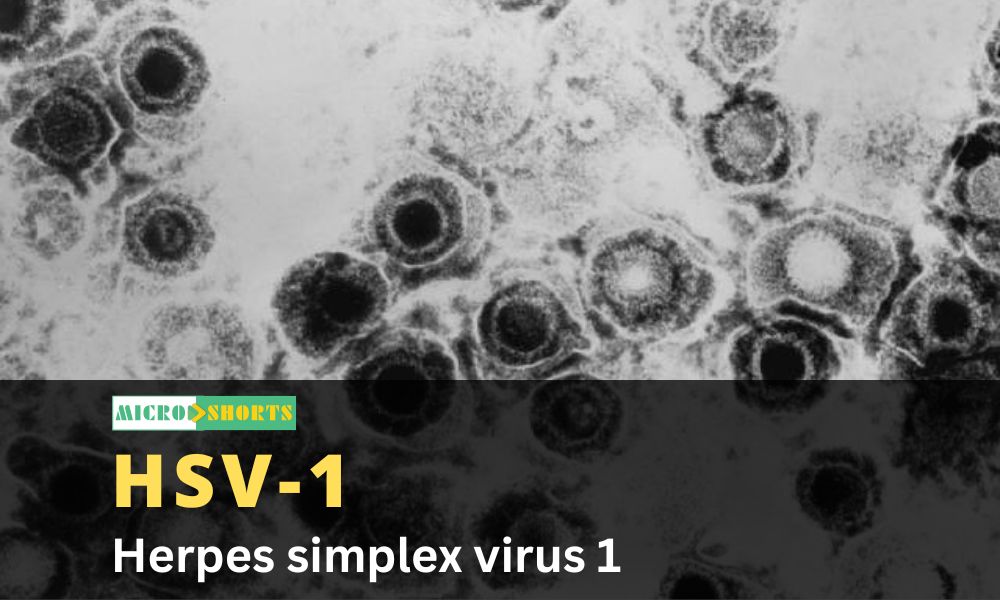



Comments